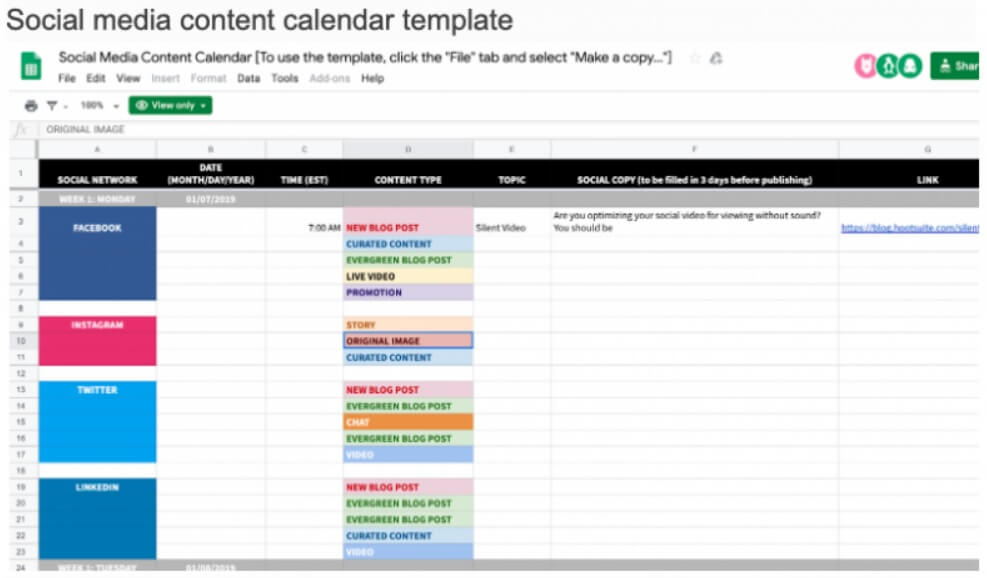On This Page: [hide]
What Is a Content Calendar?
An editorial calendar, better known as a Content Calendar is a written schedule of the time and place you plan to publish upcoming content. It can be a useful part of your SEO plan.

Is a Content Calendar Useful?
If you are running a website and do causal blogging or rarely post on a social media profile, you would not need to burden yourself with such a calendar. It will not be as useful.
Content calendars, however, can be beneficial, save you time and serve as reminders of tight business schedules. A content calendar usually includes the following:
- Upcoming Pieces
- Status Updates
- Pre-Planned Promotional Activity
- Partnerships
- Updates to Old Content
Content marketing goes hand in hand with a Calendar, as you need to plan your strategy wisely and make certain that everything goes according to that plan.
Bloggers, Businesses and Publishers find an editorial calendar useful, as it helps with newspapers, magazines, blogs, email newsletters, and social media outlets to post structured content on time and never miss to publish content in the first place.
What to Use a Content Calendar for?
Here we will give you a few ideas as a good reason to have a Content Calendar.
- Pre-Plan Content Resources – Content calendars enable your internal and external teams of content producers (writers, designers, illustrators, photographers, videographers) to be prepared in producing enthralling content on time, every time.
- Provide Visibility for Each Department – An editorial calendar helps departments within your company view upcoming content and plan appropriately. Executives can see how content is supporting the strategy of the company. Marketing teams can understand their responsibilities via a single window with a homogenous source. Sales plan communications with prospects according to upcoming content.
- Produce Creative and Engaging Content Ideas – Simply creating a calendar can also serve as regular brainstorming. Making a monthly or weekly content calendar can help your team have fun and inspire them to come up with fresh content ideas. They can pair that content with holidays, product launches and industry events and presentations.
- Keep Conversation Steady with Your Audience – A content calendar guarantees that your memos reach your prospects. Said memos could include branding messages. If prospects are further in the funnel you could drive them to take an action, such as downloading your content or fill out a form.
- Measure and Optimize Effectiveness – Creating a content calendar and scheduling your content allows you to make benchmarks easily. These benchmarks measure your content marketing effectiveness, compare performance over time, and serve to optimize your timetable.
- Use Successful Organic Content to Drive Paid Social Advertising – Planning out paid social media advertising can benefit marketers, based on the content that is successful on the organic platform. Marketers promote made videos, e-books, white papers, and other content, organically in social outlets, such as Instagram and Facebook.
As you can see above, there are plenty of content calendar benefits, which can improve your business strategy and help you to execute tasks easier.
How to Create a Content Calendar
Before all else, let us say that the sole creation of a content calendar should involve every person on all teams that will later work on completing the tasks in said calendar.
Let us start off with a few valuable tips on editorial calendar creation:
- Be Consistent – follow a structure, throughout the whole year to avoid things getting messy.
- Get Your Teams Together – bring all marketing team members into the brainstorming sessions.
- Give Some Freedom – allow marketers to make small changes on the fly as they inform everybody on the new plan.
- Give Access – everybody should be allowed to view the calendar and subsequent changes made.
- Make an Archive – Make a section in the content calendar for ideas that you can re-visit and tinker with.
Publishing content should be without impossible deadlines, incomprehensible terms and phrases and should, without a doubt, unite people of different skills to make everything easier.
Editorial Calendars can seem like a daunting activity, but it should not be so. Instead of giving firm and unchanging tasks, provide more flexibility based on the marketing teams you have already employed.
It would be wrong to assign a technical writer to make content that is way more suitable to a marketing copywriter as some companies still try to do.
With all things said so far, let us point the basic steps for creating a content calendar:
- Audit your social networks and content.
- Choose your social channels.
- Decide what your calendar needs to track.
- Make a content library for your assets.
- Establish a workflow.
- Start crafting your publications.
- Review and improve schedule based on feedback.
All that you need now is to begin publishing and scheduling new content.
Examples and Templates of an Editorial Calender
Different approaches exist and each company decides which one to take into the creation of a content calendar in the first place. Then it is another story on how every company makes changes to the plan and what amount of time the content calendar covers.
While some companies make a content calendar once per year with detailed scheduling throughout the year, others think in more realistic terms and change things or make new content calendars quarterly or even monthly.
Deciding what you will post consistently every day, week, month or quarter is up to you.
Next, you need to make sure that daily or weekly posts are not hard to produce and make.
You need to post, let us say, one Facebook post (150 words, 1 picture and 1 URL) on a daily basis, make sure it is consistent, not only with the time, but the content quantity and quality. You can make such a post every two weeks, instead.
What is left is to figure out what your audience finds acceptable in terms of branding. Not every post should be brandless or the opposite – full of brand logos, advertisements and a sales pitch every few lines.
Make posts which are actually useful to your audience, clients, fans, prospects, etc. From time to time, remind them of your brand and also make posts specific to the products you want to sell.
Just do not make every post a shovel for marketing. Find a balance and you will see how people will seek out your content.
Here is what a social content calendar template looks like:

As you can see, that is a really simple, down-to-earth understanding of how easy things should be with the creation of a content calendar.
You can use apps such as Google Sheets or Trello to easily create content calendars for free and have a single, unified place, as a repository of sorts, to store your content calendar.
Conclusion
If you are a casual blogger, this calendar is not for you. Businesses on the other hand can benefit from planning a content marketing schedule as they save time, never miss publishing content and could make more money to help improve their strategy.
An editorial calendar can be of huge help to any business as it can make their content marketing strategy more efficient.
Bigger firms and companies take up content creation seriously and involve their marketing teams in the planning of content calendars. That is more efficient than making a calendar and then getting everybody involved. Content calendars should create achievable goals and a stress-free team-building experience to truly serve as beneficial to everybody involved.
